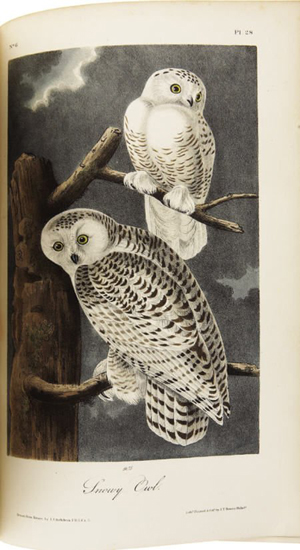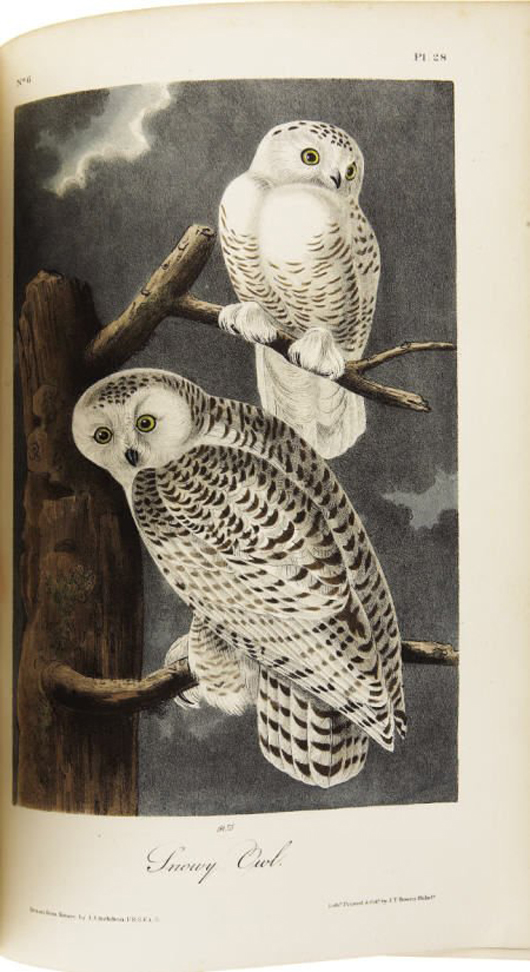
PHILADELPHIA (AP) – One of the world’s rarest and most valuable books is out of the vault and on public view as part of an unusual daily ritual at the oldest natural history museum in the United States.
Every weekday at 3:15 p.m., a white-gloved staff member of the Academy of Natural Sciences lifts the locked protective cover from 19th century naturalist John James Audubon’s influential book, The Birds of America, and turns a large linen-backed page to reveal the bird of the day. More than 180 years after Audubon created the life-size illustrations that now link his name with ornithology, their vibrant watercolors and fine details are still remarkable.
“Many times these were framed as artworks and faded from exposure to light,” said curator Robert Peck, who does many of the page turnings. “Ours weren’t exposed to light, so they’re in wonderful condition.”
The Academy of Natural Sciences was an original pay-as-you-go subscriber of The Birds of America from 1827 to 1838. The complete folio of 435 hand-colored copper engravings on handmade paper, each measuring about 2 feet by 3 feet, cost $1,000—the equivalent of around $40,000 today, Peck said.
Every month or so during those years, Birds of America subscribers received a set of five prints—usually one large show-stopper of a bird like the hot-pink Roseate Spoonbill, along with four prints of smaller species. Audubon created 87 sets of five in all; the museum bound its completed collection into five volumes.
“Some of the birds hadn’t even been discovered yet when he started,” Peck said.
Last year in London, a privately owned complete edition of The Birds of America sold at auction for $11.5 million—a record-breaking price for a single book.
“He was so great at these paintings and he was such a wonderful character,” Peck said. “He was a great storyteller with lots of anecdotes about his experiences of discovering these birds in the wild.”
Audubon traveled for decades to observe birds in their habitats and to hunt samples he used as his models for his masterwork, which allowed people to see exotic species in incredible detail and full color before the invention of photography. In the studio, he posed them with wire in positions he observed from nature and included details specific to each bird’s territory.
Several birds in the book are now extinct, including the once plentiful Carolina Parakeet and Passenger Pigeon. During his fieldwork, Audubon discovered more than two dozen new species and was lauded by 19th century scientists such as Charles Darwin for his efforts.
The Birds of America long spent its days out of public view in the Academy of Natural Sciences’ rare books vault, available only to scholars by appointment, until officials decided recently to bring their treasure out of hiding. Its age, value and superb condition means displaying the book must be done with great care, however.
With a two-handed, white-gloved, gentle turn of the page, Peck revealed the Black Skimmer to the “oohs” and “ahs” of about a half-dozen people on a recent afternoon. There are no frequent visitors in this group but Peck said a few “regulars” have become familiar faces at the page turnings.
“We’ve been here since the doors opened, and we were about to leave when the announcement came on that this was happening,” said Diana Gehman of Barto, 50 miles north of Philadelphia, who brought two of her grandsons to the museum. “I’m so glad we stayed to see it.”
Aidan McQuade, 9, and Kieran McQuade, 7, are admittedly bigger fans of snakes—so a sneak peek Peck provided of an upcoming American Anhinga page got their attention. Its long neck resembles a snake ready to strike when the Anhinga—also called a snakebird—is swimming.
“They love the outdoors, they love nature,” said Gehman, a retired teacher. “So much land has been lost to development … it’s incredible how much (the landscape) has changed. It’s important to appreciate what we have.”
The bird of the day, and a preview of birds the next couple of page-turnings will reveal, can be seen on the museum’s website. Visitors can see it in person as part of the price of general admission, which is $12 for adults and $10 for children.
“There are only about 60 institutions in the nation that have the original edition of The Birds of America,” said Clare Flemming, an archivist at the museum. “I don’t know of any other place that turns the page for the public every weekday.”
___
Online:
Audubon bird of the day: http://www.ansp.org/activities/audubon.php
Copyright 2011 Associated Press. All rights reserved. This material may not be published, broadcast, rewritten, or redistributed.
AP-WF-11-26-11 1821GMT
ADDITIONAL IMAGE OF NOTE


